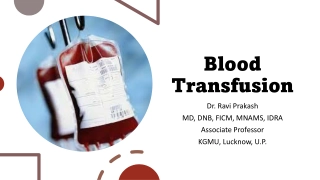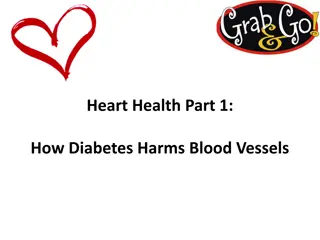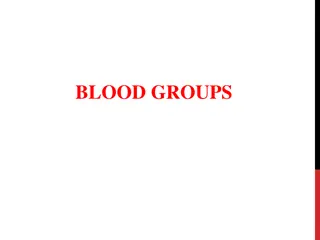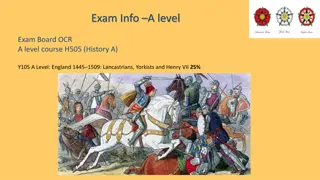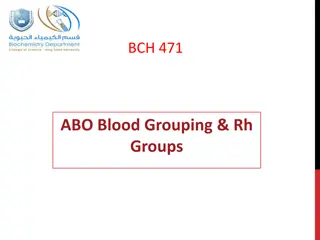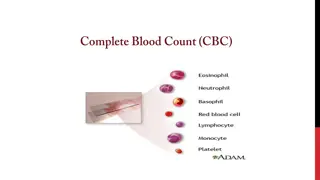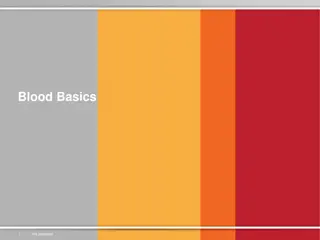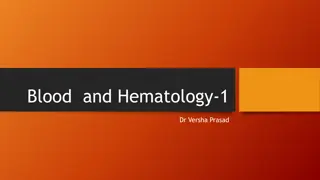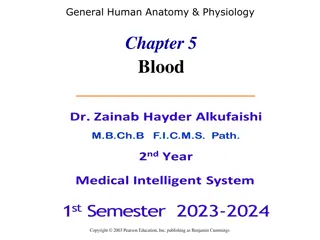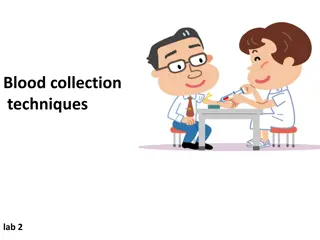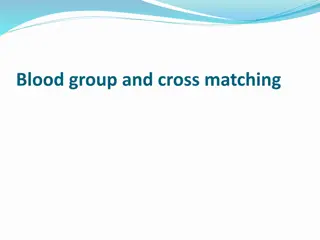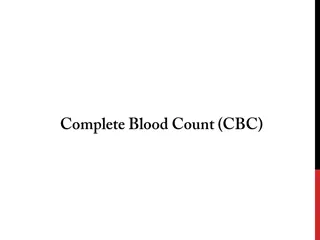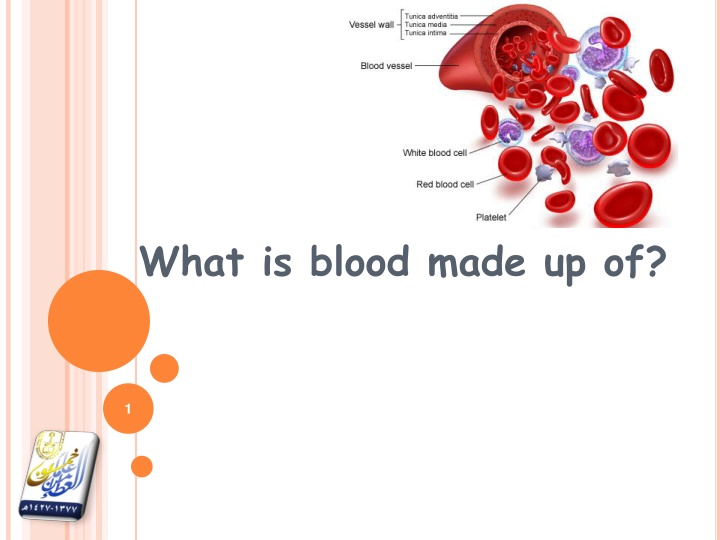
Fascinating Insights into the Composition and Functions of Blood
Discover what blood is made of, its components, physical properties, and vital functions in the human body. Explore the essential roles of blood in transportation, regulation, protection, and more.
Download Presentation

Please find below an Image/Link to download the presentation.
The content on the website is provided AS IS for your information and personal use only. It may not be sold, licensed, or shared on other websites without obtaining consent from the author. If you encounter any issues during the download, it is possible that the publisher has removed the file from their server.
You are allowed to download the files provided on this website for personal or commercial use, subject to the condition that they are used lawfully. All files are the property of their respective owners.
The content on the website is provided AS IS for your information and personal use only. It may not be sold, licensed, or shared on other websites without obtaining consent from the author.
E N D
Presentation Transcript
Blood is a fluid tissue made up of water, many types of chemicals and millions of cells. Blood volume 4-6 liters depending on sex, size and age (~8% of TBW). pH slightly alkaline 7.35 7.45; venous blood will have a lower pH because it has a higher concentration of CO2. 2
Color arterial blood is bright red and venous blood is dark red. 3
COMPONENTSOF WHOLE BLOOD Plasma (55% of whole blood) Buffy coat: leukocyctes and platelets (<1% of whole blood) Formed elements Erythrocytes (45% of whole blood) Withdraw blood and place in tube with anticoagulant 2 Centrifuge 1 4
BLOODPLASMA Includes over 100 different dissolved solutes 6
SERUMISFLUIDLEFTWHENBLOODCLOTS = PLASMA CLOTTINGFACTORS Serum Blood clot Withdraw blood and place in tube without anticoagulant 1 2 Centrifuge 7
Blood performs three major functions: Transportation Regulation Protection Gases (O2, CO2) pH: by using blood proteins and blood solutes alkaline reserve of bicarbonate ions Immune system Protect against infections by WBCs and antibodies Nutrients(glucose, lipids, amino acids, vitamins, minerals) Waste products (urea, uric acid, creatine, ammonium salts, lactate) Water balance Clot Electrolytes balance Formation Preventing blood loss by platelets and Fibrinogen Ions Hormones Temperature 8 Metabolites
PHYSICALPROPERTIESOFBLOOD Specific gravity: - Whole blood: - Plasma: 1.055 - 1.065 1.024 - 1.028 Viscosity: 5-6 times that of water. Mass: 6-8% of the body weight. 9
PHYSICALPROPERTIESOFBLOOD (CONT) Blood volume: ~ 8% of body weight. ~ 86% ml/kg body weight. 5-6L in adults [Infants have a larger blood volume in proportion to body weight than adults]. Osmotic pressure: 7-8 atmosphere at body temperature. 10
FUNCTIONSOFPLASMA Liquid portion of blood. Acts as solvent and suspending medium Water (91.5%) for components of blood; absorbs, transports and releases heat. Plasma Protein (7.0%) Exert colloid osmotic pressure , which helps maintain water balance between blood and tissues and regulates blood volume Smallest and most numerous blood plasma proteins; produced by liver. Albumin Transports proteins for several steroid hormones and for fatty acids. Produced by liver and plasma cells, which develop from B lymphocytes. Globulins Antibodies help attack viruses and bacteria. Alpha and beta globulins transport iron, lipids and fat-soluble 11 vitamin.
FUNCTIONSOFPLASMA Inorganic salts. Positively charges ions (cations) include Na+,K+,Ca+,Mg2+; Negatively charged ions (anions) include Electrolytes Cl-,HPO42-,SO42-,HCO3-. Help maintain osmotic pressure and plays essential roles in function of cells. Products of digestion pass into blood for distribution to all body cells. Includes amino acids (from proteins), glucose(from Nutrients carbohydrates), fatty acids and glycerol (from triglycerides), vitamins and minerals. Oxygen, Carbon dioxide and Nitrogen. More O2 is associated with hemoglobin inside red blood cells; more CO2 is dissolved in plasma. N2 is present but has no known functions in the body. Gases 12
FUNCTIONSOFPLASMA Enzymes, produces by body cells, catalyze chemical reactions. Regulatory Hormones, produced by endocrine glands, regulate metabolism, Substances growth and development. Vitamins are cofactors for enzymatic reactions. Most are breakdown products of protein metabolism and are carried by blood to organs of excretion. Waste Products Include urea, uric acid, creatine, creatinine, bilirubin and ammonia. 13
COMPLETE BLOOD COUNT (CBC) Panel of tests that examine different components of the blood. 14
COMPLETE BLOOD COUNT (CBC) WBC count: Actual number of WBC/ blood volume WBC differential: Types of WBC present Platelets (PLT): actual number of PLT/Blood volume RBC count : Actual number of RBC/ blood volume Hemoglobin (Hb): Amount of the oxygen carrying protein in the blood 15
COMPLETE BLOOD COUNT (CBC) (CONT) RBC indices Mean Corpuscular Volume (MCV ): a measurement of the average size of RBCs Mean Corpuscular Hemoglobin (MCH ): the average amount of oxygen-carrying hemoglobin inside a RBC. Mean Corpuscular Hemoglobin Concentration (MCHC): the average concentration of hemoglobin inside a RBC. Red Cell Distribution Width (RDW): a variation in the size of RBCs 16
CBC values: Hematocrit: The fraction of the blood volume comprised of RBCs is termed the hematocrit (volume of RBCs/Total volume of blood Plasma (55% of whole blood) x100) Normal values Males 47% +/- 5% Females 42% +/- 5% Buffy coat: leukocytes and platelets (<1% of whole blood) Formed elements Erythrocytes (45% of whole blood) 17
THESIGNIFICANCEOF CBC Find the cause of symptoms such as fatigue, weakness, fever, bruising, or weight loss Diagnosis of anemia Estimation of blood loss Find an infection Diagnosis of blood diseases as leukemia Response to drug or radiation treatment Screening before surgery 18 Abnormal count of certain types of cells
TABLE 1: The Complete Blood Cell Count Parameter Normal adult range Male: 14.0 17.4 mg/dL Female: 12.0 16.0 mg/dL Indications Low: Anemia High: Polycythemia Hemoglobin Male: 42% 52% Female: 35% 48% Low: Anemia High: Polycythemia Hematocrit Male: 4.5 5.5 x 106/ L Female: 4.0 5.0 x 106/ L Low: Anemia High: Polycythemia RBC count Low: Leukopenia High: Leukocytosis WBC count 5.0 10.0 x 103/ L Low: Thrombocytopenia High: Thrombocytosis Platelet count 140 400 x 103/ L Reticulocyte count (immature RBCs) Low in anemia: Low marrow output High: RBC loss 0.5% 1.5% 25 85 x 103/ L MCV 80-100 fL MCH 27-31 pg MCHC 32-36% RDW 11.5-14.5% 19 Data extracted from: Fischbach FT. A Manual of Laboratory and Diagnostic Tests. Philadelphia, Pa: Lippincott Williams & Wilkins; 2003:47.

